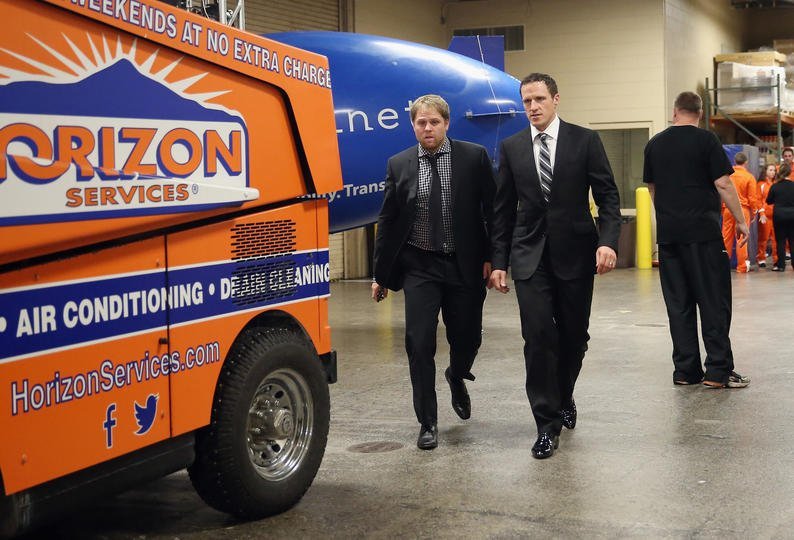Darren Dreger is reporting that a contract extension for Dion Phaneuf is near completion, as in it could be signed and sealed before the New Year. The long rumoured figures have The Captain’s new deal in the neighbourhood of 7×7. Phaneuf would join David Clarkson, Joffrey Lupul, Phil Kessel, James van Riemsdyk and Tyler Bozak as ‘core’ members of the team locked up through to the end of the 2018 season (or beyond).
Here’s an important point of consideration when analyzing the upcoming extension for Phaneuf – Relative Compensation under a rising cap.
C. The Rising Cap and Leafs Contracts
Leaving aside last off-season when the Upper Limit of the salary cap shrank from $70.2 million to $64.3 million (which was CBA mandated and which we can thank for having Mason Raymond on a $1 million contract), salaries for free agents escalate year-over-year. This is simply the economic reality of professional hockey, and generally speaking, professional sports. In 2007-2008, the average salary of an NHL player was $1.9 million; in 2013 it’s about $2.5 million. That is an increase of 32% in six seasons, one of which included a half-season lock-out.
To put that in context, the Upper Limit is projected to increase about 25% in the next 3 seasons, and 55% by the end of the CBA in 2022, which suggests that the cap is set to rise at a rate that is about fast as the recent historical rate of salary increases for NHL players.
Why am I telling you this? I’m telling you this because it means we have to think about player contracts differently. Given the (rapidly) rising salary cap, the important number in evaluating a player’s value to the team is not the player’s average cap hit as a dollar figure, but the percentage that dollar figure makes up of the Upper Limit in any given year. This amount tells us not only what the player’s value is to the team, but also the impact of the player’s salary on the team’s ability to surround him with other talented players. Let’s call this figure the player’s “Relative Compensation”.
(i) Relative Compensation
The Relative Compensation figure makes sense for a team like the Leafs because it indicates what percentage of the Upper Limit (and as a cap team, the Leafs’ will spend to the Upper Limit) the player accounts for, and how much of the Upper Limit will be left to sign other players. Based on what we know, for every year of term on a player’s contract it is safe to assume two things; first, that his Relative Compensation will decrease as a function of the rising cap, and second, that the cost of acquiring a similarly talented UFA will increase as average salaries continue to rise. That being the case, and as long as a player is performing consistently, he’s providing greater relative value in each following season.
The trick if you’re a GM trying to sign a free agent is to figure out a salary number and a term that allows the player’s Relative Compensation to be less than or equal to his level of play for as many of the contract years as possible. When a UFA is signed it’s not unlikely that his cap hit and Relative Compensation will exceed comparable players in the short-term, this is just the reality of signing a new contract, especially with UFA’s. However, as time progresses the player should become relatively more valuable than a comparable player as his Relative Compensation decreases and the cost of signing a comparable player as a free agent increases – all of which assumes that the player’s level of play has not suffered significant regression at the time of comparison.
The Relative Compensation statistic is also useful because it allows us to make historical comparisons between players who are making different salaries across a number of seasons, based on the percentage of the Upper Limit the player’s cap hit accounted for during any given season. By doing this comparison we can estimate whether the cap hit associated with a player in a current season is, relatively speaking, of equal value to a player of comparable talent in a previous season, as well as roughly estimate what a player of comparable talent should cost (in cap dollars) in the future. All of which allows us to determine whether the player being compared is providing value to his team relative to his cap hit.
(iii) Relative Compensation: Dion Phaneuf
This season Dion Phaneuf is making $6.5 million in the last year of a 6 year deal. His Relative Compensation is 10.1%. At 10.1%, Phaneuf’s Relative Compensation is not far removed from a player like Zdeno Chara – he of the Norris Trophy and Stanley Cup. So is Dion Phaneuf overpaid by a little? Probably.
Now let’s assume for the sake of argument that Phaneuf signs the $7 million times 7 year contract that Kypreos reported last month. Let’s assume also that by year 3 (the 2016-2017 season) that a 31 year old Phaneuf has not seen any significant regression in his game, which I would argue is a fair assumption given his play this season and his relative durability over his career.
In year 3, when the cap is projected to reach $80 million dollars, Phaneuf’s Relative Compensation would be 8.75%, and he’d actually be more valuable to the Leafs, relatively speaking, than he is during the 2013-2014 season despite his increased cap hit.
For comparison sake, let’s look at what Relative Compensation of 8.75%, which equates to $5.625 million this season, buys you.
NHL Defenseman Currently Making Similar Relative Compensation
| Buffalo Sabres | Tyler Myers | $5.5 million |
| Columbus Blue Jackets | James Wisniewski | $5.5 million |
| Calgary Flames | Dennis Wideman | $5.25 million |
| Dallas Stars | Sergei Gonchar | $5 million |
| MontrŽal Canadiens | Andrei Markov | $5.75 million |
| Pheonix Coyotes | Oliver Ekman Larsson | $5.5 million |
| Pheonix Coyotes | Keith Yandle | $5.25 million |
| Philadelphia Flyers | Kimmo Timonen | $6 million |
| Philadelphia Flyers | Mark Streit | $5.25 million |
| Pittsburgh Penguins | Paul Martin | $5 million |
| San Jose Sharks | Brent Burns | $5.76 million* |
| Tampa Bay | Matt Carle | $5.5 million |
| Vancouver Canucks | Alexander Edler | $5 million |
| Washington Capitals | Mike Green | $6.08 million |
| Winnipeg Jets | Tobias Enstrom | $5.75 million |
*Brent Burns signed this contract in August, 2011 and was not converted back to forward by the Sharks until March of the following season.
Looking at this list, if Dion Phaneuf is making $7 million in 2016-2017 then his decreased Relative Compensation of 8.75% could not be expected to buy a team the equivalent of a Zdeno Chara, so Chara is no longer a fair comparable. As the list above demonstrates, with maybe a couple of exceptions, the defensemen with a Relative Compensation of 8.75% are not “stud” number one defensemen in the Chara mould, but either good-to-very good second-pairing guys, or offensive specialists with defensive limitations.
Is Dion Phaneuf a high-end second pairing defenseman? In his sleep. This is a player that plays the toughest minutes on his defensively porous team every night, yet still sits at +12. Phaneuf plays both of the special teams, is good for about 40 points a season, and wears the ‘C’ in one of the toughest media markets in the NHL. Add to that his penchant for opportune goal scoring (I count 24 game-winning goals to his NHL resume), and his ability to lay a big hit or fight, and you’ve got the makings of a very good, if not quite elite all-around defenseman. As the list above demonstrates, that description is on the positive side of what a team can expect to get for Relative Compensation of 8.75%.
What’s more, is it reasonable to expect that in 2016-2017, when the Upper Limit has reached $80 million, that a team will be able to acquire a player of 31 year old Phaneuf’s calibre and spend less than 8.75% Relative Compensation (or $7 million); especially in light of rising player salaries?
Either way that you break it down, Dion Phaneuf is likely to provide value to the Leafs at $7 million until 2018-2019 when he’ll be 33 and should be expected to decline. At that point he’ll have completed 5 of his 7 contract years, or 70% of his contract. For a free agent to provide value relative to his contract for at least 70% of his contract is actually pretty good. In order to achieve the same feat, Ryan Suter will have to be playing up to his $7.58 million dollar contract until the 2020-2021 season.
Furthermore, given that the cap is forecasted to reach $100 million by 2022, which is the year after Phaneuf’s proposed deal would end, his Relative Compensation will also continue to fall for the life of his deal, and it will not be necessary for him to play at his current level in order to provide value relative to his contract.
All of which is to say, if we can get Dion to sign on the dotted line for $7 million or less, for 7 years or less, then that’s a deal the Toronto Maple Leafs can and should live with, and we have Rogers and 6 outdoor games this season to thank for it.


































